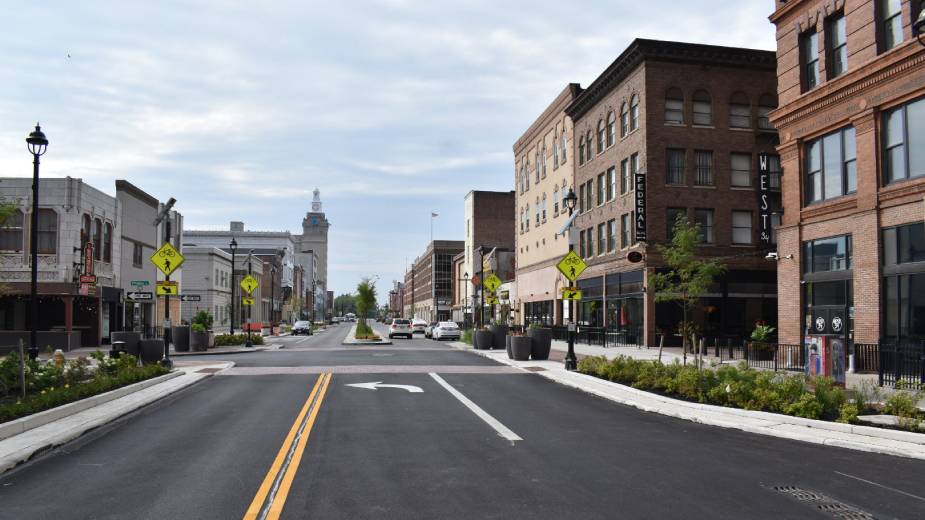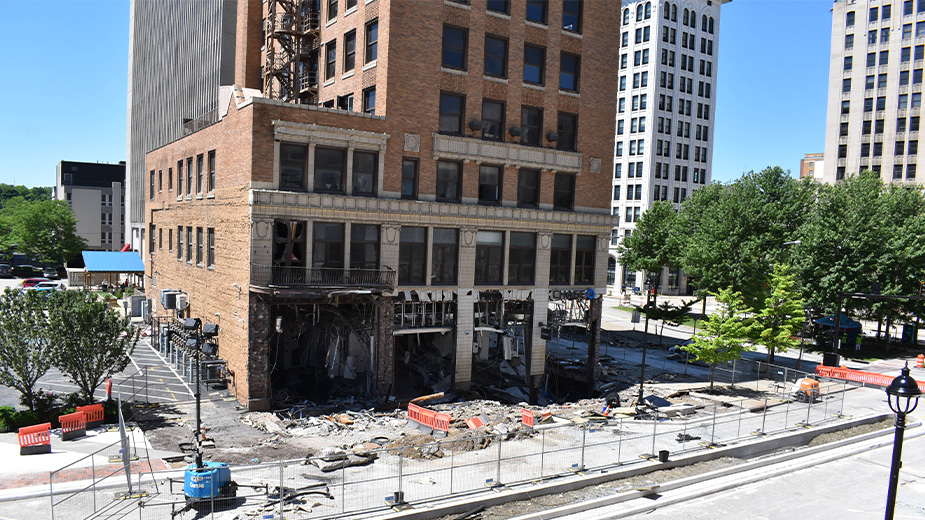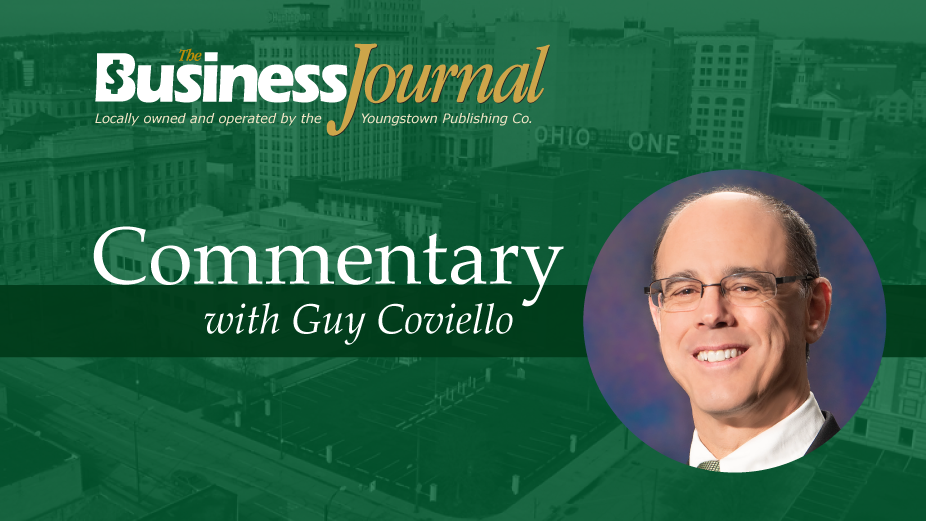Youngstown Gets $100K for Downtown Reboot Planning
YOUNGSTOWN, Ohio – What is being described as a strategic reboot plan for downtown is envisioned as a starting point for future redevelopment efforts in a four-county region.
In a news release, Lake to River Economic Development said grants totaling $100,000 will be used to conduct the plan focusing on downtown Youngstown. JobsOhio, the state’s private economic development corporation, will provide a $50,000 grant that the Youngstown/Warren Regional Chamber Foundation will match with its own $50,000 grant.
“This is a great example of the resources Lake to River hopes to bring together,” Alexa Sweeney Blackann, the organization’s interim CEO, said Wednesday. “This is the start of other opportunities that we hope JobsOhio and Lake to River can bring to our four-county region.”
The JobsOhio Pre-Project Planning Grant is part of a program designed to help communities take a project from the idea phase to the implementation phase and to attract future investment, business activity and jobs, according to the release. The $50,000 grant is the largest of its kind to have been awarded since JobsOhio launched the program in 2019.
“JobsOhio’s Planning Grant is intended to lift downtown Youngstown in the short term while empowering a local vision that can catalyze future economic success,” said J.P. Nauseef, JobsOhio president and CEO. “We and our partners at Lake to River are looking to build on existing relationships to spark more business and activity in the heart of downtown Youngstown for years to come.”
Lake to River, the JobsOhio partner established earlier this year to represent Ashtabula, Columbiana, Mahoning and Trumbull counties, sought the funds for the downtown plan following the May 28 natural gas explosion at the Realty Tower, Blackann said.
The explosion left a Chase Bank employee dead, obliterated the bank’s Realty Tower offices and displaced the tenants of the building’s 23 apartments. Concerns over the building’s stability left the adjacent International Towers apartment building and Stambaugh Building shuttered for weeks. Realty was demolished over the summer.
“The explosion put this to the forefront. No one expected that devastating explosion in May. So our team began looking for ways that we could help using the resources at JobsOhio, and this opportunity came about,” Blackann said.
She acknowledged that while the May 28 explosion began the conversation, the purpose of the grant goes beyond a single downtown building.
“It’s really about who are we in the future? What will we do together? What opportunities are available beyond the Realty building, specifically. And what do we want to put our focus behind?” Blackann said.
The Youngstown/Warren Regional Chamber will co-lead the project by engaging and gathering data from key stakeholders in downtown Youngstown. The emphasis will be on creating a locally tailored plan, promoting advocacy for incentives and business attraction and identifying sector gaps for future growth.
Downtown Youngstown has faced “significant challenges in recent years,” Guy Coviello, chamber president and CEO, said in the news release.
“We are proud to match JobsOhio’s funding to help reboot and transform downtown and look forward to collaborating with partners to foster long-term economic growth,” he said.
In addition to the May 28 explosion, downtown and its businesses have suffered from reduced business during the Covid-19 pandemic in 2020, which closed downtown hospitality establishments for several weeks and changed employment patterns, leading many workers to leave downtown. Ongoing downtown road projects over the past four-plus years also have restricted downtown activity.

Economic Action Group, a local organization, developed the reboot strategy/re-envision plan and will facilitate its execution, according to the release. The plan is organized into two phases, starting with developing the reboot strategy. This phase involves rapidly engaging with on-the-ground businesses and other stakeholders, prioritizing addressing immediate needs to restore confidence and activating downtown through focused programming, using existing assets.
“It’ll be engaging with downtown stakeholders to find the emerging trends, but it’ll be focused on different perspectives of downtown, such as downtown stakeholders and downtown businesses, future development, programming,” said Nick Chretien, EAG co-founder and executive director.
“We’ve been through Covid. We’ve been through construction and the recent struggles. But how do we emerge stronger from that using the existing infrastructure and stakeholders we have here at the table?” Chretien continued. EAG will engage a broad cross-section of downtown stakeholders, including ground-floor retail businesses such as bars and restaurants, community anchors, cultural institutions, philanthropy, social service agencies, financial institutions, professional firms and property owners.
“The goal will be to collaborate with local and regional planning partners to develop a strategy that addresses both immediate and long-term needs downtown,” he said.
Within the next few months, EAG would like to have the first phase finished – immediate action steps that could be recommended to be undertaken through partners such as the recently formed downtown Planning Committee, Chretien said. Such steps could be taken in the next six months or at least by the end of the first half of 2025. Then there would be recommendations for longer-term actions over the next three to five years.
“By leveraging collective expertise and stakeholder input, we aim to positively shape the future of downtown during this critical time,” he said.
Phase two encompasses the “downtown re-Envision” component. EAG will develop a comprehensive long-term vision and action plan to build a vibrant, resilient downtown through strategic investments in people, place-making and sustainable programming, while continuing to build on existing assets.
The plan involves seeking additional funding sources to cover the costs of implementation.
Achieving sustainable, long-term success for downtown “requires a comprehensive strategic plan that involves broad representation and input from our stakeholders, which is what this project will include,” Stephanie Gilchrist, Youngstown’s director of economic development, said in the release.
“We’re appreciative of the collaboration, timely action and funding commitments from JobsOhio and the Regional Chamber Foundation, and we’re excited about the prospects of identifying additional investment sources when it comes time to execute this plan,” she continued.
Investments such as these in planning are often catalytic, according to Blackann.
“It lets you study the market,” including what buildings are available, “and really gets partners in the community thinking about the opportunities available in a downtown like Youngstown,” she said. “And sometimes an investment like this for the planning grant really gets some of those investments started.”
Pictured at top: The Realty Tower, which was damaged by a May 28 explosion, is seen on May 31.
Copyright 2024 The Business Journal, Youngstown, Ohio.



